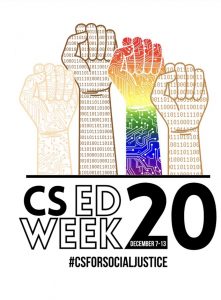Some people hear the words computer science and only think of coding but ask any computer scientist and they would tell you that coding is just a tool to solve important and interesting problems. At its core, computer science is about using technology to solve complex problems in the world, and many of the problems solved (and discoveries made) because of computer science have permanently reshaped the way we live, work and communicate. For example:
 Search engines were developed to solve the issue of information overload, connecting people to the most relevant information available on the internet. Now, these platforms have so drastically changed how we access the world’s information that we've seen huge shifts in the role of formal education.
Search engines were developed to solve the issue of information overload, connecting people to the most relevant information available on the internet. Now, these platforms have so drastically changed how we access the world’s information that we've seen huge shifts in the role of formal education.- Social media platforms were built to give people a faster and easier way to connect with one another. Now they've transformed the way many people communicate and even the ways companies and governments do business.
- Countless applications have been built to connect people with services they need, whether it’s a ride, grocery delivery, or a handyman. These applications have revolutionized the current gig economy and changed how work gets done.
When we view computer science through this lens it's easy to see how technology could have substantial impacts on the world around us, including areas like social justice. For this change to occur however, we have to ensure that the field of computer science is diverse, well-informed and views the world’s problems with empathy and creativity.
Solving problems with empathy and computer science
There are endless problems in the world that need to be solved or improved. So, who gets to decide which problems are worth solving with technology? Those decisions often lie with people who have the skills to create technology-driven solutions. Many applications used today were initially inspired by problems a computer scientist saw in their world and believed they could solve with their own technical skills. Without a diverse set of experiences and perspectives, there are a lot of problems that will be left unknown and unsolved, further exacerbating issues of inequity or injustice.
For example, imagine a low-income community where students are bused across town for school. Traffic in this community is particularly irregular and, because of the great distances involved, the bus may arrive 20 minutes early or 20 minutes late on any given day. Many parents in this community work demanding jobs and are unable to drive their children the long distance to school. With those factors in mind, we then have to consider the impact busing irregularity has on children and a child’s education:
- Students within this community will likely miss the bus or be late to school because of the irregularity of transportation.
- Other students in the community may simply not attend school that day.
- Overtime, the school may begin to see lower student attendance and lower test scores.
From the outside looking in, you might not see that the underlying problem of student attendance in this community is due to traffic patterns and bus routes. Initially, all you can see is a community with poor school attendance, resulting in worse educational outcomes and a cycle of poverty that perpetuates. However, someone who digs deeper and works to understands the source of the problem and the needs of the community might be able to design a technological solution that could break this cycle. An app that tracks the bus routes or alters the bus’s starting time or routes based on traffic patterns could increase school attendance and educational opportunities for the community overall.

Awareness of the problems people face is the first and most important step in finding a solution. From there, it’s all about having the skills and resources to bring about the necessary change. Technology is particularly well-suited to addressing a wide variety of problems, but this can only help with social justice if the people with the skills to use technology to solve problems are representative of the complicated world we live in.
Reducing bias in technology
Humans are known to be biased decision makers. Many of the social justice movements we've witnessed have focused on combating these biases in high-impact fields like criminal justice and the job hiring process. But what about computers? Surely, they can be unbiased?
Unfortunately, that’s not the case. Software is built by humans and can only be as unbiased as the people responsible for building and evaluating it. This is especially critical as we continue to build more applications with AI and machine learning. These applications make decisions by learning from data. If the data that goes in is biased, the decisions made will also be biased.
Having diverse representation in computer science isn’t a magic cure to resolving the issues of bias, but it's a significant step in the right direction. Diverse perspectives matter. Diverse perspectives help increase awareness about possible systemic biases in judgement that may inadvertently make their way into the technology and tools we create, use and rely on. Beyond diversity, increasing awareness of social issues and developing empathy among those who build technology is critical if we are to realize the potential technology has to bring about social change.
What can you do to help?
 An easy way to get involved is through Computer Science Education Week (CSEdWeek) which runs Dec. 7-13. Take inspiration from CSEdWeek’s 2020 theme of social justice and see how you might reach and inspire a diverse group of young learners -- especially those who are currently underrepresented in the field. Consider the populations that are less likely to be exposed to this field of study in their educational career. Find ways to connect with these students (virtually during the pandemic and in-person post-pandemic) and ask them about the problems they wish they could solve with technology. Conversations like these help spark curiosity among students and allow students to see the power computer science has in their everyday life.
An easy way to get involved is through Computer Science Education Week (CSEdWeek) which runs Dec. 7-13. Take inspiration from CSEdWeek’s 2020 theme of social justice and see how you might reach and inspire a diverse group of young learners -- especially those who are currently underrepresented in the field. Consider the populations that are less likely to be exposed to this field of study in their educational career. Find ways to connect with these students (virtually during the pandemic and in-person post-pandemic) and ask them about the problems they wish they could solve with technology. Conversations like these help spark curiosity among students and allow students to see the power computer science has in their everyday life.
Are you an educator or passionate volunteer working with students who are already learning computer science? Consider bringing social justice into the computer science conversation and connecting it to the material students are already learning.
However you plan to get involved with #CSEdWeek2020, the following resources may help inspire you:
- Hour of Code has a large library of introductory CS activities for all ages and topics. We especially love this activity that introduces the concept of bias in AI.
- GatherIQ has a variety of resources for learning more about issues of social justice through the lens of the UN Sustainable Development Goals.
- Code for America provides inspiration for how technology is being used to have real impacts on social justice issues.
